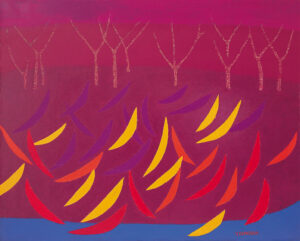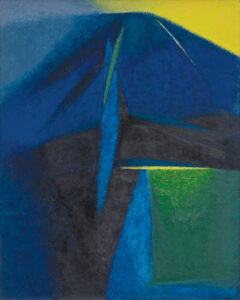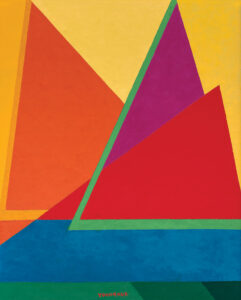
Yoo Youngkuk, celebrated at home as a groundbreaking modernist painter, is having his first solo exhibition outside South Korea
By Lilly Wei
Yoo Youngkuk once said that he used the mountain as his principal motif because it contained everything that was needed in painting: color, straight and curved lines, and light. Like Cézanne, he treated nature as geometric forms, substituting rectangles, circles, and triangles for the French master’s cylinder, sphere, and cone. For Yoo, the triangle represented the mountain; the circle referred to the sun or the moon–the source of light; and the lines were their illuminating rays, pressing the natural world into two-dimensional geometric shapes and into pure colors and light. He also said that the subject of his oeuvre is nature, which he explores through non-figurative forms, through lines, planes, and colors, that is, through abstraction, in his search for clarity and the immutable.
Work, 1968, oil on canvas, 136 x 136 cm.
© Yoo Youngkuk Art Foundation, courtesy Pace Gallery.
And who was Yoo Youngkuk? He was a pioneering abstract artist considered to be one of South Korea’s foremost modernist painters who will be introduced to New York this month in a comprehensive survey of his work at Pace Gallery, his first solo exhibition outside his native country. Revered at home (to the degree that signing his paintings with his first name was sufficient), he has inspired several generations of Korean abstract painters, and his work is seemingly always on display somewhere in South Korea. Nonetheless, he is all but unknown beyond its borders, despite a degree of international exposure—São Paulo and Basel, for instance. Global economies, geopolitical power alignments, and tastes, however, have shifted yet again. The once insular and impoverished nation has been for some time now a stable democracy with a steadily expanding economy and one of the most reliable of America’s (and the West’s) allies in the region. It is therefore not surprising that Seoul has recently become a venue of much interest to the contemporary art world, and its artists, from established to emerging (and across the cultural spectrum from K-pop to K-dramas to award-winning films and filmmakers), are now eagerly sought after to swell the ranks of Korean artists who are already celebrated on the international art circuit, although very few among them are painters.
Yoo was born in 1916 in Uljin-gun in Gyeongsangbuk-do province, famed for the beauties of its forests, mountains, lakes, and bordered by the Sea of Japan. He died in 2002 in Seoul, his life spanning nearly the entirety of the 20th century. It was a century of exceptional turmoil and suffering for Korea, from its occupation by the Japanese from 1910 to 1945 and the end of World War II, followed by its sundering into North and South, which led to the Korean War (officially still being fought since no formal peace treaty has ever been signed), to the seesawing of South Korean governments between democracies and dictatorships, the latter brutally suppressing civil rights in pursuit of accelerated economic growth.

Work, 1980, oil on canvas, 81 x 100 cm.
© Yoo Youngkuk Art Foundation, courtesy Pace Gallery.
In 1935, Yoo, born into a family of means, went to Tokyo, which was then the East’s gateway to the greater world, enticed by its cosmopolitanism, despite Japan’s harshly discriminatory policies toward Korean émigrés, studying at the Tokyo Institute of Culture (Tokyo Bunka Gakuen). He was instantly, instinctively drawn to abstraction, taking classes with avant-garde artists who had been to Paris and mingled with the Cubists and Surrealists, and befriending other progressive creators. Yoo was keenly interested in Russian Constructivism and Suprematism, movements long known in Tokyo, just as he was intrigued by Mondrian and other non-objective painters. Experimenting with materials and techniques, including photography, he dedicated himself to an abstract aesthetic, disinterested in realistic work. Yet despite his philosophical embrace of geometric abstraction, after an initial exploration of the purely formal, he pivoted to landscape, though he peeled it down to its geometric bones in a bold adaptation and balancing of the traditional and the radical.
By 1943, the war made it impossible for him to remain in Tokyo, so he returned to Seoul. As the Japanese withdrew from Korea in 1945, the restoration of the country to independence was as chaotic and traumatic as life had been during the occupation. Yoo eventually retreated to Uljin to supervise his family’s distillery and, always enterprising, re-fitted an old boat and launched a successful fishing business, retreating from the center where his individuality of thought was suspect, as was his long residence in Tokyo. After overseeing the family’s business for 10 years as a hands-on owner who labored side by side with his workers, he was able to step down to devote himself fully to his art again, ruefully calling the previous period his “lost decade.” But ultimately, it was not lost; the time he spent in Uljin rekindled his youthful connection to the land, deepening it. It also provided him with his lifelong subject. Mount Seoraksan and the Taebaek range became his muses, his talismans, much as, say, Mont Sainte-Victoire was Cézanne’s or, more recently, Mount Tamalpais was Etel Adnan’s. Yoo observed and painted his mountains under all conditions, at all times of the day and night. And even though he re-located back to Seoul, he would return to Uljin for long periods of time, to be soothed and replenished by its mountains and uplifted by their charisma and sense of permanence.
Work, 1981, oil on canvas, 73 x 100 cm.
© Yoo Youngkuk Art Foundation, courtesy Pace Gallery.
By the 1950s, he had more or less determined the direction of his art: abstract landscape depicted in brilliant, saturated colors, employing line to delineate forms. Questions that fascinated him and that he asked himself time and again focused on concerns such as: how to simplify; how to flatten the three-dimensional object onto a two-dimensional support; how to structure space using geometry, reducing the ephemeral to essential form; how to use the objects in a space to demarcate depth, distance; and how to define and abstract all of that? In no rush to find the answers, Yoo allowed himself time to resolve these questions, which then bred new questions; or new resolutions were found for old questions. The process was ultimately as much, if not more, important than the completed work, which was ongoing, as he explored yet another possibility. (It should be noted that other, more pragmatic reasons for his contemplative pace of making art and experimenting included the paucity of collectors in those years and the fact that materials for painting were often difficult to obtain.) Yoo, in his development, in some ways recapitulated the history of modernism—from non-objective, monochromatic, color field, and abstract expressionism to his personalized interpretation of abstraction in which discernible representation of the world is a constant—yoking his intense feeling for abstraction with his equally intense feeling for the beloved mountains and waters of his native province. He was not simply seeking pictorial fidelity; he was in pursuit of existential truth.

Work, 1966, oil on canvas, 163.2 x 130 cm.
© Yoo Youngkuk Art Foundation, courtesy Pace Gallery.
His most productive period was in the 1960s, when he spent long hours in his studio daily. The forms in his paintings became more compact, the composition tighter, while the contour lines of his shapes softened and bled into each other, and the primaries and complementaries that characterize his work blazed into an alluring new richness. They display the foundational role that color had assumed as the paintings’ building blocks, one that is only loosely correlated with that of nature, representing no reality more than that of the painting itself. As the decade advanced, his triangles became more clearly mountains even if his color scheme remained subjective. A work from 1966 is deep blue, the bent edge of its shapes like the mountain’s profile, abutting a glow of yellow as if dawn were about to break while others might be warmer in tonality, consisting of reds, yellows, and purples, suggesting a mountain engulfed by a superheated sun. At times, they might be almost monochromatic, such as a stunning red beauty (and he has a way with red) from 1968, its surface diagonally crossed from corner to corner to divide it into four triangles, while a tiny triangle/mountain holds the center, tipped by a darker shade at its apex.
In the ‘70s, there is a shift toward the more legibly representational. The paintings are hard-edged, with a pronounced preference for diagonals and diamond shapes. The curved, peaked profile of traditional Korean architecture appears and, of course, his beloved triangular mountains. One work from 1975, a trio of summits in ruddy maroon to orange—close in value, unexpected combinations of colors are another of Yoo’s hallmarks—is patched with little colored triangles, as if to flag them, pinning them in place, claiming them.
By the late ‘70s and early ‘80s, he made even more overtly recognizable landscapes and seascapes. The former might depict trees in the shape of the letter “Y”; one painted in 1979 in bands of warm, subtly graduated mauves to rose suggest a semblance of foreground, middle ground, and background; at the bottom of the painting is a ribbon of bright blue that signifies water. Red and yellow elliptical shapes are scattered in the foreground from the bare trees behind, like autumn leaves about to be swept away by the stream beneath.

Work, 1995, oil on canvas, 39 3/8 x 31 1?2 in.
© Yoo Youngkuk Art Foundation, courtesy Pace Gallery.
There are also seascapes, some divided into a choppy expanse of short streaks of pale blue that approximates the sparkle of light on water, contrasted with the longer sweep of more smoothly undulating waves in the foreground, which also might be land or mountains painted in a cool refreshing, lighthearted aquamarine. The artist often said viewers could read his paintings as they wished. Yoo’s scenes do not usually depict foliage, moving water, dwelling on the still and unchanging rather than the fugitive, but there are exceptions.
Yoo returns to more emblematic landscape in the ‘90s. The poetic, even haunting painting of the night sky in shades of blue and black is lit by a pale double moon: one in the sky, one a reflection—or not—as water, land, and mountain exchange identities, the viewer again not certain which is which, the ambiguity, again, intentional. Another work from that period, made a little later, is full of color, consisting of several large triangles of related tones edged in contrasting colors. While we know they are surrogates for mountains, the triangular shapes can easily be seen and enjoyed as pure abstractions, toggling between abstraction and representation as always.
Yoo’s health began to fail in the 1970s. That slowed him down but did not stop him; he continued to paint for nearly another 20 years, his last painting made in 1999, three years before his death. His was a lifelong quest for something to cherish, believe in, for some eternal verities to trust, which he found in his faithful mountains. The epitaph on his gravestone reads: “The mountain stays in my mind.”

